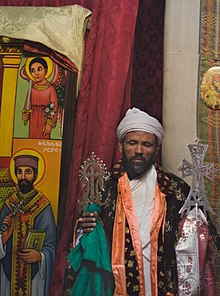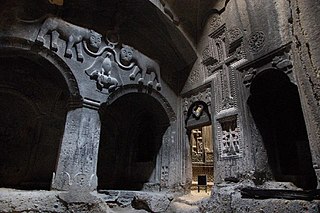
A monolithic church or rock-hewn church is a church made from a single block of stone. Because freestanding rocks of sufficient size are rare, such edifices are usually hewn into the ground or into the side of a hill or mountain. They can be of comparable architectural complexity to constructed buildings.

The Church of Saint George is one of eleven rock-hewn monolithic churches in Lalibela, a town in the Amhara Region of Ethiopia. Originally named Roha (Warwar), the historical and religious site was named Lalibela after the King Gebre Mesqel Lalibela of the Zagwe dynasty, who commissioned its construction. He is regarded as a saint by the Ethiopian Orthodox Tewahedo Church.

Lalibela is a town in the Amhara Region of Ethiopia. Located in the Lasta district and North Wollo Zone, it is a tourist site for its famous rock-cut monolithic churches designed in contrast to the earlier monolithic churches in Ethiopia. The whole of Lalibela is a large and important site for the antiquity, medieval, and post-medieval civilization of Ethiopia. To Christians, Lalibela is one of Ethiopia's holiest cities, and a center of pilgrimage.

The Dazu Rock Carvings are a series of Chinese religious sculptures and carvings and UNESCO World Heritage Site located in Dazu District, Chongqing, China. The carvings date back as far as the 7th century AD, depicting and influenced by Buddhist, Confucian and Taoist beliefs. Some are in rock-cut cave shrines, in the usual Chinese Buddhist style, but many others are rock reliefs carved into the open rock faces. Listed as a World Heritage Site in 1999, the Dazu Rock Carvings are made up of 75 protected sites containing some 50,000 statues, with over 100,000 Chinese characters forming inscriptions and epigraphs. The sites are located in Chongqing Municipality within the steep hillsides throughout Dazu District, located about 165 kilometers west of the urban area of Chongqing. The highlights of the rock grotto are found on Mount Baoding and Mount Beishan.

The Amhara Region, officially the Amhara National Regional State, is a regional state in northern Ethiopia and the homeland of the Amhara, Awi, Xamir, Argobba, and Qemant people. Its capital is Bahir Dar which is the seat of the Regional Government of Amhara. Amhara is the site of the largest inland body of water in Ethiopia, Lake Tana, and Semien Mountains National Park. Amhara is bordered by Sudan to the west and northwest and by other the regions of Ethiopia: Tigray to the north, Afar to the east, Benishangul-Gumuz to the west and southwest, and Oromia to the south. Towns and cities in Amhara include: Bahir Dar, Dessie, Gonder, Debre Birhan, Debre Tabor, Kombolcha, Weldiya, Debre Markos, Seqota, Kobo, Metema.

The Zagwe dynasty was a medieval Agaw monarchy that ruled the northern parts of Ethiopia and Eritrea. The Agaw are a Cushitic ethnic group native to the northern highlands of Ethiopia and neighboring Eritrea. It ruled large parts of the territory from approximately 1137 to 1270 AD, when the last Zagwe King Za-Ilmaknun was killed in battle by the forces of the Amhara King Yekuno Amlak. The Zagwe are most famous for their king Gebre Meskel Lalibela, who is credited with having ordered the construction of the rock-hewn monolithic churches of Lalibela.

Rock-cut architecture is the creation of structures, buildings, and sculptures by excavating solid rock where it naturally occurs. Intensely laborious when using ancient tools and methods, rock-cut architecture was presumably combined with quarrying the rock for use elsewhere. In India and China, the terms cave and cavern are often applied to this form of man-made architecture, but caves and caverns that began in natural form are not considered to be rock-cut architecture even if extensively modified. Although rock-cut structures differ from traditionally built structures in many ways, many rock-cut structures are made to replicate the facade or interior of traditional architectural forms. Interiors were usually carved out by starting at the roof of the planned space and then working downward. This technique prevents stones falling on workers below. The three main uses of rock-cut architecture were temples, tombs, and dwellings.

Lalibela, regnal name Gebre Meskel, was a king of the Zagwe dynasty, reigning from 1181 to 1221. He was the son of Jan Seyum and the brother of Kedus Harbe. Perhaps the best-known Zagwe monarch, he is credited as the patron of the namesake monolithic rock-hewn churches of Lalibela. He is venerated as a saint by the Ethiopian Orthodox Tewahedo Church on 19 June.

Na'akueto La'ab was King of Zagwe dynasty. According to Taddesse Tamrat, he was the son of Kedus Harbe. Richard Pankhurst credits him with the creation of the church located in a cave a half-day's journey from the town of Lalibela. According to a manuscript Pedro Páez and Manuel de Almeida saw at Axum, Na'akueto La'ab ruled for 40 years, a suspiciously round number.

The architecture of Ethiopia varies greatly from region to region. Over the years, it has incorporated various architectural styles and techniques.
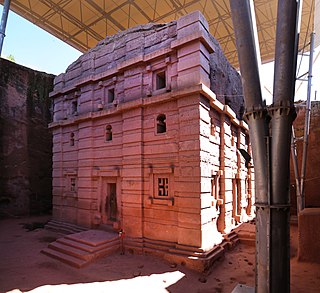
Biete Amanuel is an underground Orthodox monolith rock-cut church located in Lalibela, Ethiopia. The edifice was built during the Kingdom of Axum. It is part of UNESCO World Heritage Site at Lalibela. Biete Amanuel is possibly the former royal chapel.

Biete Abba Libanos is an underground rock-cut monolith Orthodox church located in Lalibela, Ethiopia. It was built during the Kingdom of Axum. It is part of UNESCO World Heritage Site at Lalibela.
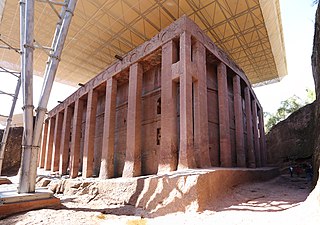
Biete Medhane Alem is an Orthodox underground monolith rock-cut church located in Lalibela, Ethiopia. It was built during the Zagwe dynasty. It is part of the UNESCO World Heritage Site at Lalibela. Biete Medhane Alem is home to the Lalibela Cross.

Biete Meskel is an Orthodox underground monolith church carved into rock. It is located in Lalibela, Ethiopia. The edifice was built during the Kingdom of Axum. It is part of UNESCO World Heritage Site at Lalibela.
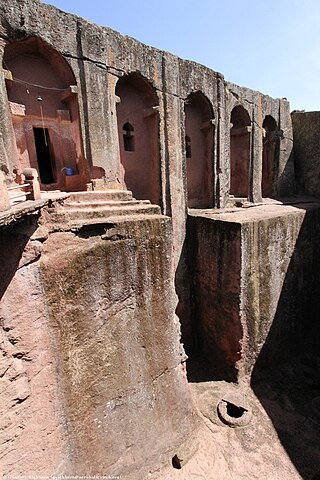
Biete Gabriel-Rufael is an underground monolith rock-cut church located in Lalibela, Ethiopia. The Orthodox church was built during the Kingdom of Axum. It is part of UNESCO World Heritage Site at Lalibela. Biete Gabriel-Rufael is possibly a former royal palace, linked to a holy bakery.

Biete Qeddus Mercoreus is an underground Orthodox rock-cut monolith church located in Lalibela, Ethiopia. It was built during the Kingdom of Axum. It is part of UNESCO World Heritage Site at Lalibela. Biete Qeddus Mercoreus may be a former prison because of ankle shackles found there.
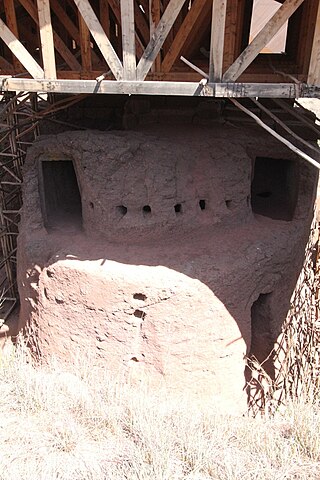
Biete Lehem is an underground monolith church carved into rock. It is located in Lalibela, Ethiopia. It was created during the Kingdom of Axum. It is part of UNESCO World Heritage Site at Lalibela. The name Biete Lehem is from Bethlehem Hebrew: בֵּית לֶחֶם.
The Washa Mikael Rock-Hewn Church is a rock-hewn semi-monolithic church located in the Yeka district of Addis Ababa, the capital city of Ethiopia.

Adadi Mariam is a rock-hewn monolithic church located approximately 66 km southwest of Addis Ababa, Ethiopia. A popular tourist destination, the site is believed to have been built in the 12th century.

The eleven Rock-hewn Churches of Lalibela are monolithic churches located in the western Ethiopian Highlands near the town of Lalibela, named after the late-12th and early-13th century King Gebre Meskel Lalibela of the Zagwe dynasty, who commissioned the massive building project of 11 rock-hewn churches to recreate the holy city of Jerusalem in his own kingdom. The site remains in use by the Ethiopian Orthodox Christian Church to this day, and it remains an important place of pilgrimage for Ethiopian Orthodox worshipers. It took 24 years to build all the 11 rock hewn churches.

